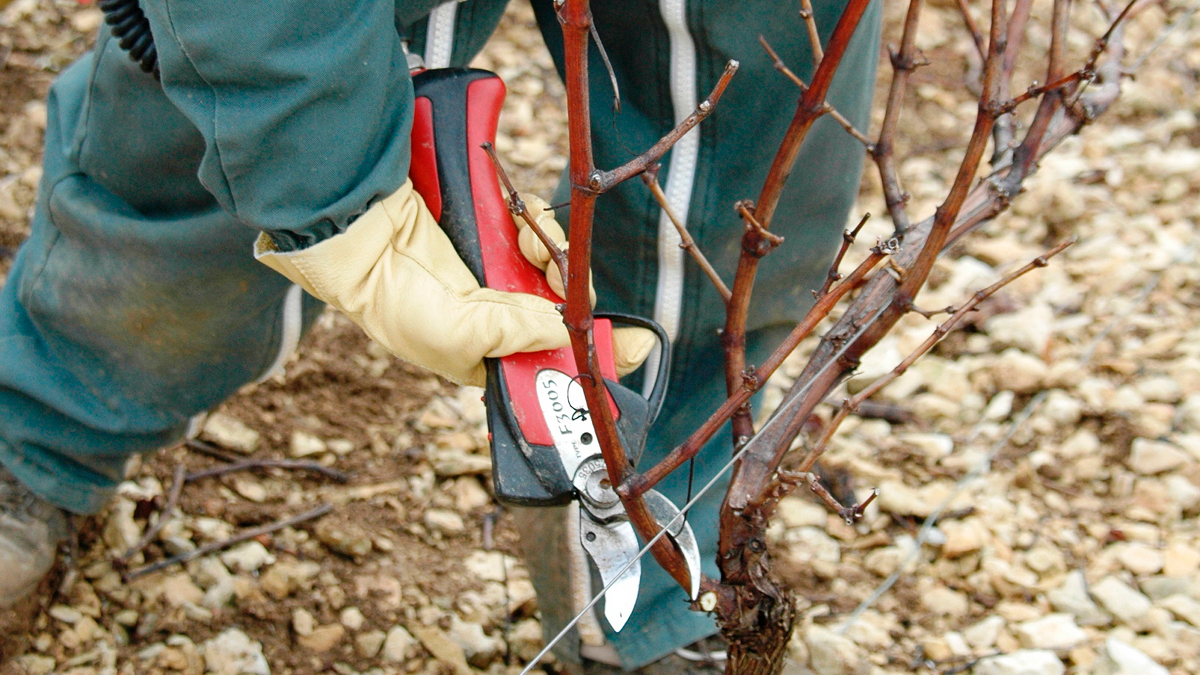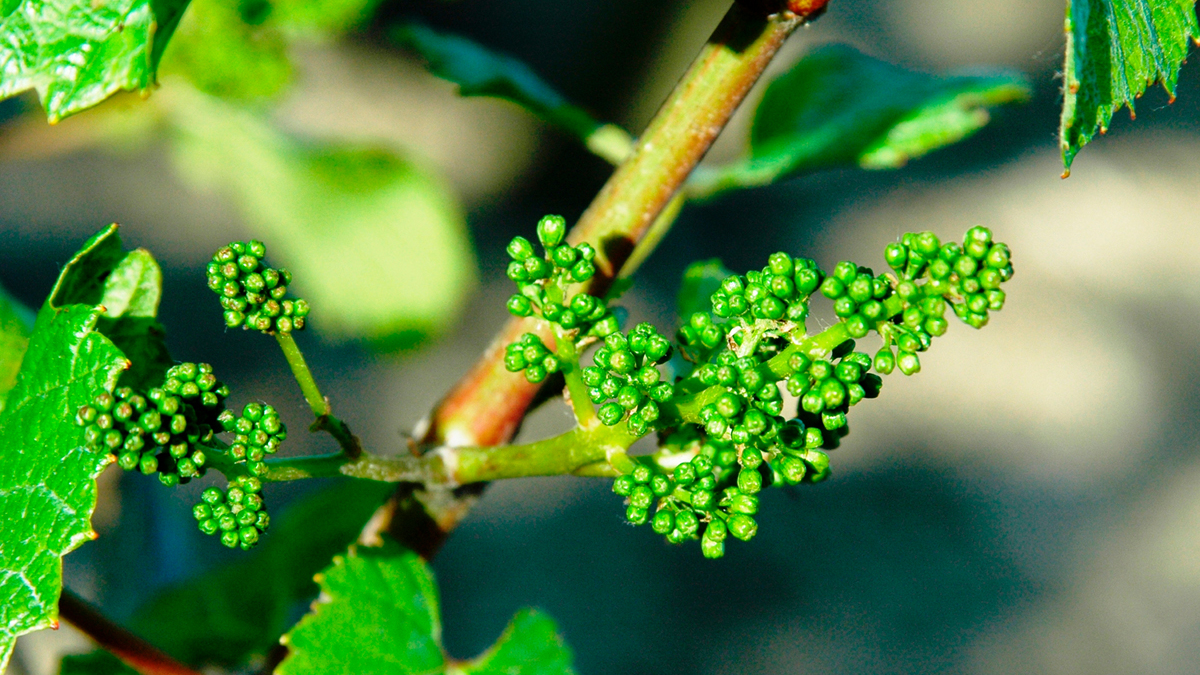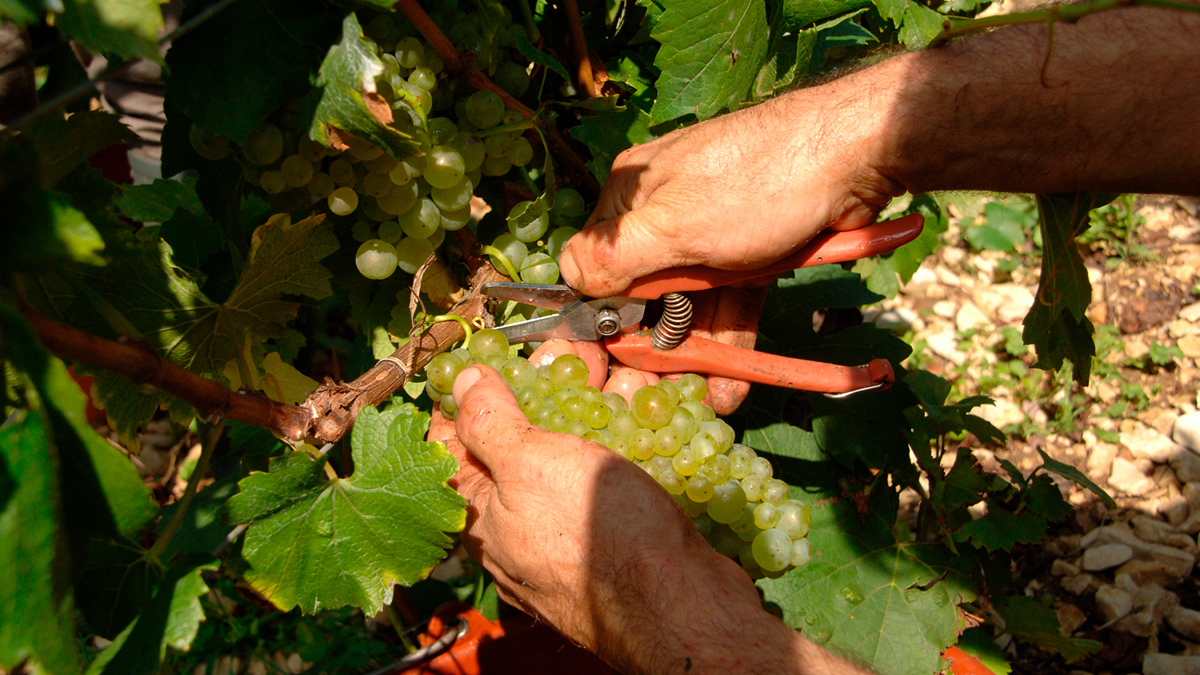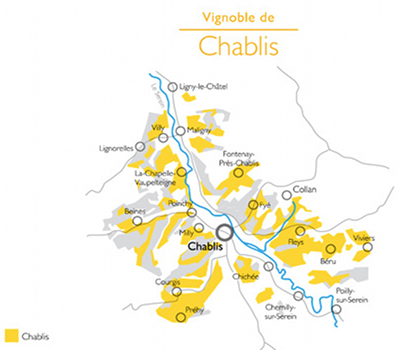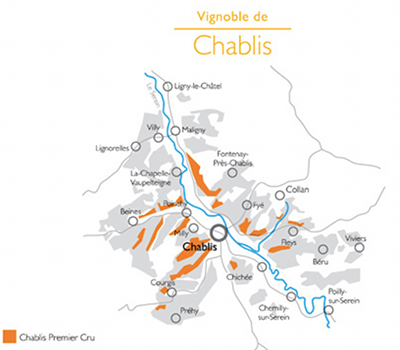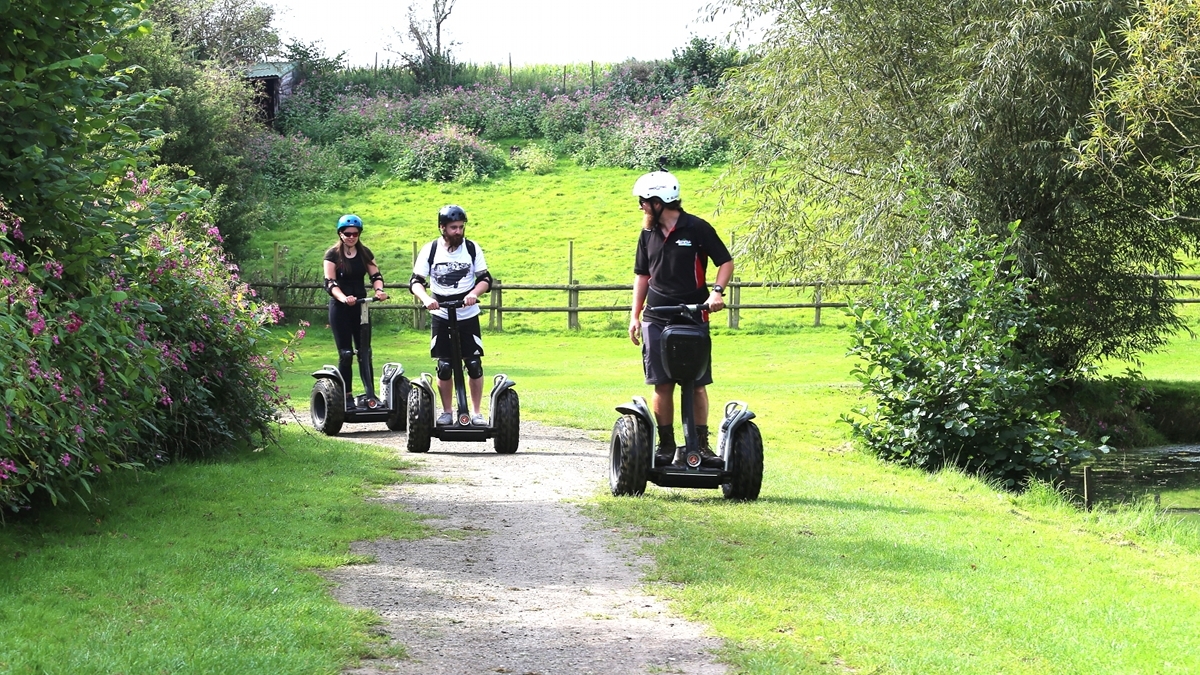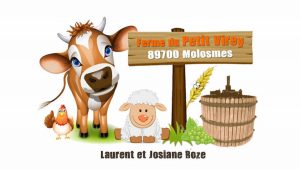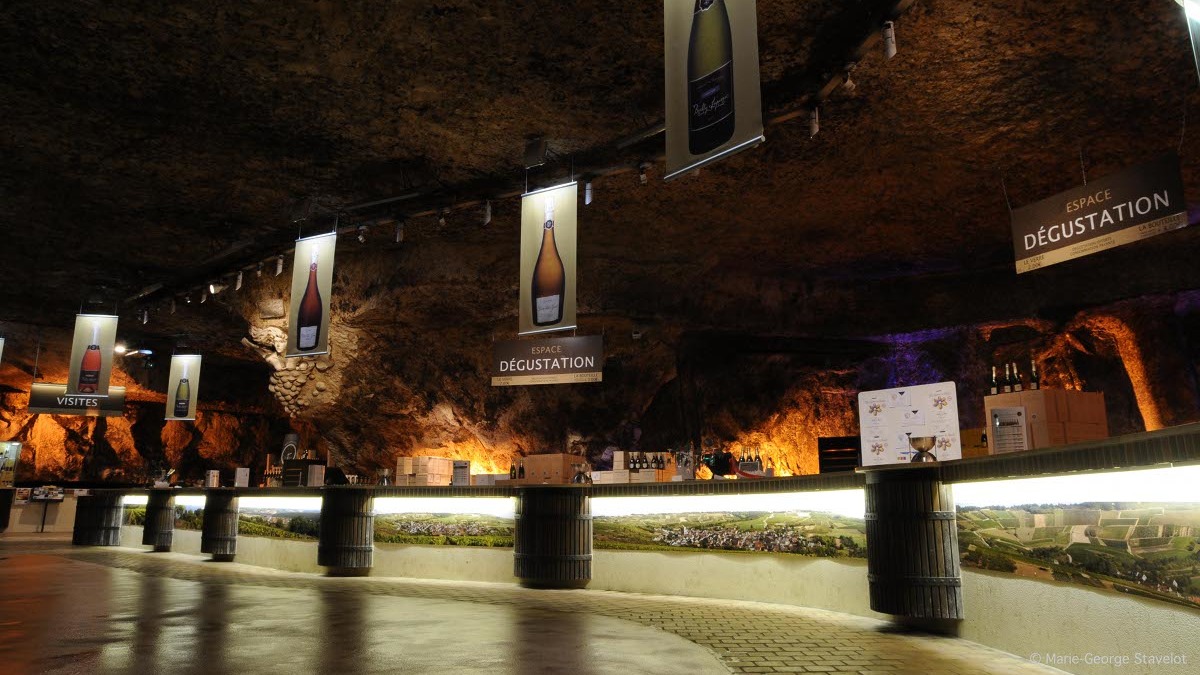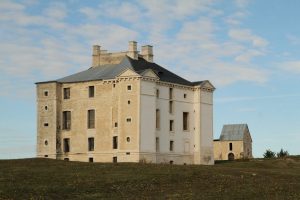Wine!
Before you get to enjoy a sip of our region’s wine, there is a long, drawn out process behind the scenes in our vineyards and cellars…
Working the Vineyards
The cutting
Botanically speaking, the vine is considered a liana, growing endlessly unless pruned. This pruning takes place in March, giving the vines time to grow back even more beautifully come springtime.
Traditionally the size ends in early March. In reality this date varies according to the domains and can spread throughout the winter. The most common size in the Burgundy vineyard is the Guyot size (single or double). You will also see other forms more specific to Chablis: “Chablis’ size”. This work which may seem simple, actually requires great practice and an expert eye. It is a question of choosing the preserved shoots that will carry the harvest. The must-have ally of size is also … the secateur!
Once the shoots are cut they remain attached to the trellis wire (wire stretched between the vines). The stains must remove them. This action is called “pull the woods”. They are picked up then and burned in burns most often “homemade”. The size being practiced during the winter period these fires have the advantage of warming the workers. This is why you often see smoke volutes rise here and there above the plots.
Work and enrich the earth for a good development of the vineyard
To grow and produce grapes the vine draws its resources from the soil. It is necessary to maintain it and to ensure its good balance. Soil maintenance involves plowing which serves to loosen and aerate. In order to rebalance the soil that has nourished the vine throughout its cycle, the winemaker must bring them the necessary mineral elements. The soil is one of the primordial components of the terroir. It must be preserved to ensure the durability and quality of Burgundy wines.
Take care of earth
From the beginning of spring, the first gestures are destined for the ground.
- The “débuttage”: the soil used to protect the vines during the winter (hilling) is removed. This plowing is used to aerate the soil and to distribute the earth.
- The “bouéchage”: this term typically Burgundy means “return the earth”. This gesture serves to remove unnecessary roots.
- The “griffage”: This shallow plowing is intended to destroy weeds, aerate the soil and bury the nutrients.
- Planting and transplanting (replacement of stocked vines) also takes place at this time.
- Weeding or mowing: the presence of grass between the rows is appropriate in certain plots in order to control the vigor of the vine. In this case regular mowing should be done. In the opposite case the plots must be weeded regularly. In Burgundy this work is increasingly done mechanically without using chemicals.
Monitoring the growth of the vines until harvest time
When the fine weather returns, the winegrower has several tasks that help encourage vigor in the vines and the development of high-quality grapes. Tying up, training and tucking in the vines : In the Bourgogne winegrowing region, the vines are supported by metal wires stretched between posts to ensure the grapes get the best exposure to the sun (trellising).
- Tying up: The winegrower attaches the canes to the lowest wires. This helps channel plant growth and encourage them to develop fruit.
- Training: As the canes grow, they are guided upwards and attached to the wires. This takes place throughout the summer months.
- Tucking in: Because vines are creepers, they tend to grow in all directions. To encourage them to grow in rows, the canes are pushed between the second row of double wires.
- Éjetonnage: This dialect word has plenty of local variations (such as évasivage). The equivalent in French is ébourgeonnage or debudding. The task is carried out by hand and involves removing the “gourmands” or the young elbow shoots that give no fruit and can divert the vine from focusing its attention on developing fruit- bearing canes and grapes.
- Protecting the vines: The vines must be protected against certain diseases such as downy mildew, powdery mildew and botrytis.
- Trimming: This task involves removing the tips of the canes to encourage fruit development. Another advantage is that this facilitates movement between the rows.
- Vendanges vertes: Just before véraison (when the grapes take on color), the vendange vert or green harvest takes place. The winegrowers may remove the excess bunches from vines, but this is not systematic. The remaining bunches can then reach optimum maturity.
- De-leafing: Depending on the weather experienced during the year, the winegrower may decide to remove some of the leaves while the grapes ripen. Only leaves facing the rising sun in the east are removed. This technique helps the grapes to ripen and offers improved aeration. Moreover, it makes the task of manual harvesting much easier.
Winemaking
The appellations
Bourgogne Tonnerre
- WINE CHARACTERISTICS
The wines are yellow or pale green with hints of silver. The nose recalls lemon zest, acacia blossom, pear, peach, fennel, stone fruits, and almond, sometimes with notes of pineapple and passion fruit. It is fleshy and fresh in the mouth with good length punctuated by touches of saline, lemon, aniseed, and licorice aromas. These wines are balanced, rounded, smooth, and mineral with a velvety sensation mid-mouth.
- SITUATION
The vineyard of Bourgogne Tonnerre is located on hillsides on either side of the river Armançon, a tributary of the river Yonne. From the 10th century onwards, the monks of the abbeys of Quincy, near Tanlay, and Saint Michel, near Tonnerre, intensified and improved winegrowing practices. The Knight of Éon, a noble from Tonnerre and diplomat under Louis XV, also used wines from Tonnerre to loosen tongues in capital cities across Europe. Since 1987, men and women have been breathing new life into this ancient winegrowing region.
- TERROIRS
The vineyard of Bourgogne Tonnerre is mainly located at the entrance to several southeast-facing valleys, at between 200-300m above sea level. The Chardonnay grape flourishes on marl-limestone formations from the Kimmeridgean and limestone from the Portlandian eras, laid down between 152-142 million years ago, during the Upper Jurassic. It is this geology that is responsible for the light-colored pebbly soil.
- WINE STEWARD’S TIP
The lemony and saline freshness of these wines is best suited to simple, marine dishes like oysters and other seafood, sushi, and fish or seafood tartare, served as a meal or as tapas. More mature vintages partner well with steamed fish, risotto, and vegetable dishes, surf’n’turf, creamy cheeses, and poultry in sauce or even foie gras for the most intrepid!
Serving temperature: 12-14°C.
Keeping potential: 3-5 years.
Bourgogne Épineuil
- WINES CHARACTERISTICS
The reds are cherry red in color and vary in intensity with touches of ruby red. The nose offers notes of cherry, blackcurrant, strawberry, pepper, licorice, and toasT sometimes with added hints of rose, violet, and blueberry. In the mouth it is fresh and fruity with sophisticated, crisp tannins, and a long, saline finish.
The rosés are salmon pink to orangey pink in color with touches of pale silvery pink. The nose offers notes of redcurrant, melon, bell pepper, and pomelo, with suggestions of rose, pepper, star anise, orange, and peach. In the mouth they are fruity, vinous, and spicy with a saline finished topped off by marine notes and hints of aniseed.
- SITUATION
The hill of Epineuil is opposite Tonnerre on the right bank of the river Armançon a tributary of the river Yonne. The abbeys of Saint-Michel and De Quincy produced highly-reputed wines here since the late Middle Ages. Under the reign of Louis XVIII Épineuil still had 362 hectares of vines before phylloxera struck. The rebirth of this winegrowing region began in 1978, driven by mayor André Durand and local winegrowers who continue to write the history of the wines of Epineuil made famous by the Chevalier d’Eon, Boileau, and Alfred Grévin, a native of the village who gave his name to the famous waxworks museum in Paris.
- TERROIRS
The vines of Bourgogne Epineuil grow on the steep slopes of a hill and a valley at between 140-265m above sea level. They face southeast, south, southwest, and northwest, sheltered from the winds blowing from the plateau of Langres. Their roots plunge into very pebbly marl-limestone soils from the Kimmeridgean and limestone soils from the Portlandian.
- WINE STEWARD’S TIP
Red: Its fruitiness and fleshy texture makes this a convincing partner to grilled salmon, sophisticated cold cuts, stuffed cabbage, œufs en meurette, roast chicken with morello cherries, quail stuffed with grapes, beef stews, braised veal, and vegetable gratins. Or try it with goat cheese, Mimolette, Reblochon, and Saint-Nectaire cheeses.
Serving temperature: 13-14°C.
Rosé: Its freshness, vinosity, and powerful fruitiness make this wine a choice companion for mixed salads, shellfish sauted with tomato, stuffed bell peppers, summer brochettes, grilled fish with vegetables in olive oil, Asian-style sautéed pork and goat cheese like Picodon.
Serving temperature: 11-12°C.
Le Crémant de Bourgogne
- WINE CHARACTERISTICS
A wine bursting with youth and audacity. Its freshness and vigour are a matter of general agreement. Given time it acquires the stateliness of a great wine. The brut faithfully reflects its lively and clear-cut personality. As demise or sec vivacity yields to smoothness and makes room for a new taste impression that of sweetness.
- The blanc is generally white-gold in colour. The bubbles are fine and form a delicate necklace around the edge of the glass. Floral, citrusy and mineral aromas are matched in the mouth by freshness and elegance plus a degree of acidity which is the key to a proper balance between aromatic power and the desired degree of lightness.
- The blanc de blancs carries the perfume of white flowers, citrus fruits or green apples. With time it will develop toasty notes and notes of pitted-fruits such as apricot or peach.
- The blanc de noirs exhales aromas of small fruits (cherry, blackcurrant, raspberry). In the mouth powerful, long and persistent. Time adds charm and warmth with aromas of dried fruits and perhaps honey, spices or nutmeg.
- The rosé made from Pinot Noir grapes with or without a proportion of Gamay is pink-gold in colour. This is a delicate wine with subtle aromas of red fruits.
As part of the strategy by Crémant de Bourgogne producers to boost the quality of the appellation the Eminent and Grand Eminent denomination were introduced in 2013.
They must meet a number of specifications regarding the production of the wine the most important of which is the amount of time they are aged on laths to bring out all the subtle aromas of the main varietals used, which are the same grapes as used in a traditional Crémant de Bourgogne. The Crémant de Bourgogne Eminent denomination requires minimum ageing of 24 months while the Crémant de Bourgogne Grand Eminent denomination calls for 36.
- SITUATION
Sparkling Bourgogne made its entrance into history in 1830 when it was lauded by the poet Alfred de Musset (1820-1857) in his “Secrètes pensées de Raphaël”. It was first made at the beginning of the 19th century at Chablis, Nuits-Saint-Georges, Rully and Tonnerre and since then has not ceased to sparkle. It was for a long time the practice to make effervescent versions of prestigious Burgundian Grands Crus but the AOC status granted in 1975 laid down strict conditions for its production on the basis of meticulously-applied traditional skills to achieve high-quality vinification. Only whites and rosés qualify for the appellation. They may be blanc de blancs (from white grapes) or blanc de noirs (from white-juiced black grapes). Most are classed as brut or less often demi-sec. The production area is the same as that for the appellation Bourgogne.
- TERROIRS
The grapes from which the vins de base for Crémant de Bourgogne are made come from a wide variety of soils in vineyard districts throughout Bourgogne.
They range from the chalky subsoil of the Joigny district in the north to the granites of southern Bourgogne via the limestones and marls of the Côtes where most of the wines of this appellation are grown.
- WINE STEWARD’S TIP
Although Crémant de Bourgogne is a perfect pre-dinner drink this in no way takes away from the fact that it is also a perfect accompaniment to food. The blanc chimes with main dishes such as stewed poultry with pears and dried fruits (confit de volaille aux poires et fruits secs).With the blanc de blancs try scallops or river fish. The blanc de noirs makes a splendid match for braised oxtail or snails with potatoes (escargots en coque de pomme de terre) and is the ideal partner for poultry such as a fattened hen from La Bresse. The rosé is a sound choice as a dessert wine with its powerful floral aromas which go perfectly with ice cream and bring a touch of freshness to the close of a meal. It is ideal with pastries and its fruit scents are unbeatable with a red-fruit sorbet.
Serving temperatures: 4 to 8°C as a pre-dinner drink or dessert wine. 6 to 9°C with main meal.
How to serve a good wine?
Sense of sight
DISTINGUISHING THE COLORS AND NUANCES
If you begin your exploration with the white wines from the north of Bourgogne, you will discover whitish-gold wines with green tinges, for example, a Chablis.
Warms golden hues appear farther south. Meursault for example will surprise you with its amber tones which become more intense with ageing.
Thanks to their unique palette of colors the red wines have a whole different story to tell, one of excellence and outstanding terroirs.
Admire the garnet red and delicate purplish-blue of the young wines. Cherry red, bright red, and mahogany all indicate the authenticity of the great Bourgogne wines.
As precious as the rubies evoked by a glass of Mercurey the colors promise asymphony of aromas.
For an original and tempting tasting experience discover the nuances of Bourgogne rosés with colors from raspberry pink to peony.
DETERMINING THE INTENSITY OF A WINE
The color of a wine depends on the quantity of pigments that are found in the grape skins depending on the varietal. It also varies according to the vintage and the method of production.
Take the time to appreciate the intensity of your wine’s appearance, known as the “robe” (light medium or deep).
With time you’ll be able to decode certain specifics: a warm and dry vintage will give a deeper color, a given method of Vinification will result in lighter wines etc.
CATEGORIZING THE BRILLIANCE
In a suitable tasting glass examine how the light plays on the surface of the wine.
Is it dazzling brilliant or crystalline ? Or on the contrary is it rather matt ?
Younger wines tend to be more crystalline and bright than older wines. This gives an idea of your wine’s age.
GAUGE THE CLARITY OF ITS APPEARANCE
The clearness of a wine corresponds to the absence of cloudiness.
Hold your glass up to the light; see if it has any haze, has any particles in suspension or if it’s perfectly clear. Watch out: don’t confuse cloudiness in a wine with a deposit at the bottom of a glass. Bourgogne wines are often made for long ageing and it is not unusual for a naturally occurring deposit to form without altering the quality of your wine. Take your tasting to the next step: swill the wine gently round the glass to see “tears” fOrm on the side of the glass. Their thickness will indicate the degree of alcohol in the wine.
Sense of smell
THE NOSE YOUR KEY TO THIS AROMATIC TRAVEL
Raise a glass of Bourgogne wine to your nose and you enter an extraordinary garden of a thousand and one odors.
Take the time to feel the emotions that the wine inspires in you. Let your imagination carry you as you stroll in a forest bite into a raspberry, smell a bunch of violets and so on.
The intensity, the power, the vintage, the type of ageing and the varietals used are all pieces of the puzzle that you can put together thanks to your sense of smell. The best way to smell a wine is to sniff with a series of short inhalations. Try to pick out the emblematic odors of Bourgogne wines: red fruits (cherries) and wild berries (blackberries, blueberries) for reds; acacia blossom and citrus for white wines for example.
AN AROMATIC EXPLORATION, STEP BY STEP
The delicacy of the aromas of Bourgogne wines opens out during the tasting in several stages. The first nose consists of smelling the wine directly without swirling it in the glass. This is when the most delicate and ephemeral fragrances can be detected.
Does the wine seem pleasant, intense, powerful, rich ?
The delicacy and profusion of aromas in Bourgogne wines enrich your olfactory journey.
Next swirl the wine gently round your glass to open it up. Sniff it and enjoy the aromas (second nose). The aeration and warming gradually intensify the odors and expand the aromatic palette.
Floral, fruity, mineral or spicy, the odors abound to reveal the depth and authenticity of your Bourgogne wine. The final stage of tasting takes place in the mouth.
Sense of taste
YOUR PALATE, A KEY PART OF TASTING
Taste and smell are closely linked and allow you to explOre the aromas of a wine, both through its flavors and its mouth feel. Sip a small quantity of wine. Roll it around your mouth to wash it over your palate, whilst sucking in a little air. In Bourgogne, this action is known as “grumage”. It oxygenates the wine in the mouth. This requires a little practice, but it helps release certain aromas that where hitherto masked. These will rise up to the nose from the back of the palate. This is called retronasal olfaction.
Continue your sensorial exploration with the aid of your tongue. Your taste buds allow you to detect basic flavors:sweet, sour and bitter. Notes of honey or vanilla found in certain Bourgogne whites like Puligny-Montrachet can be detected by the tip of your tongue.
The sides will recognize the more acidic flavors which provides the crispness and tension in a wine and which is desirable in a lively white wine like a Chablis or a Bourgogne Aligoté.
Beyond the aromas and the flavors, your mouth also allows you to employ your sense of touch. Astringency is that sensation of harshness on the palate, the gums and cheeks. It is produced by the tannins and is mainly found in red wines. It should not be too pronounced.
You may also notice warmth linked to the degree of alcohol.
A GRADUAL “MISE EN BOUCHE”
The first impression of a wine is called the attack. It gives a glimpse of the qualities of a wine and its aromatic palette. It is at this point that you can tell if a wine is pleasant (smooth), if it lacks structure (lifeless) or if it is assertive (lively).
The Bourgogne winegrowing region is known for its balanced wines at the heart of which acidity, alcohol and astringency merge together. When it comes into contact with the saliva the tannins which give structure and character to red wines really come across. Are they too present and aggressive? Or are they pleasant and smooth in the mouth?
Continue your gustatory exploration by examining the body of the wine, driven by the alcohol. What place does the wine take in your mouth? Is it discreet (thin), clearly present (fleshy) or dense ?
The wine’s finish enables one to appreciate the wine as a whole. Is it agreeable, aromatic or astringent ?
Once you have swallowed it the wine will still impregnate your palate for a few seconds. This is known as the wine’s length in the mouth. Its duration is calculated in seconds or caudalies.
œnotouristic activities
Fournillon domain
While stopping off at the Fournillon family estate, you can mix oenology and heritage. In these wine-makers estate you can find the “Emperor’s Vineyard” (one of the only vineyards that has been resistant to phylloxera), a vineyard that is home to the Chardonnay grape that dates back nearly 200 years. Do not skip this!
Alain Mathias domain
Since 1982, Alain Mathias has been going that extra mile to develop his family estate and today it is run by his son Bastien and his step-daughter Carole. The estate offers you a range of PDO wines from the vineyards of Chablis, Épineuil and Tonnerre, most of which are certified as organic. You can taste the wines in the cellar all year long.
Céline Coté domain
Since 2010, this estate has provided typical organic wines with that distinctive mineral Tonnerrois flavour. The estate will be delighted to warmly welcome you and explain all about what the wine-maker does and more specifically how they make Céline Coté, where the vineyards are worked in a traditional way with a draft horse.
Marsoif domain
This estate has an age-old wine-making tradition: The knights Templar founded the commandery in 1235 in a strategic location. Located in Tonnerre, the winery, where the wine is prepared and where the large vaulted cellar can be found at the foot of the vineyards and the canal of Burgundy, is open for tours and tastings. In Serrigny, between Tonnerre and Chablis, the vaulted cellar invites you to taste different wines.

Val Grévin domain
Found in the heart of the wine-maker village of Épineuil, in an old house “Le Clos des Sens”, the Val Grevin estate invites you to discover the best of its terroir, by visiting its vaulted cellar. Go and discover all the treasures that the estate has to offer and share with you. Please do not hesitate to contact the owner for a warm welcome and also to take advantage of the hiking-tasting offer!

Petit Béru domain
Come and meet our passionate owners, for a tasting in their cellar or their original winery that they built themselves. It is there that you will discover typical and quality wines from the region as well as their range that has been made using old techniques, a “superior range” that has been matured in oak casks and that is available as white or red wine.
Bailly-Lapierre cellars
The exploitation of underground Bailly quarries dates back to the Middle Ages. The very good quality of the limestone has served until the twentieth century to the construction of monuments such as castles, churches (such as Pontigny Abbey) and cities. Transportation was facilitated by the Yonne River flowing down the quarries. These are home to the Bailly-Lapierre Cellars where Crémant de Bourgogne is made.From April to the end of September from Tuesday to Saturday (excluding the grape harvest period) at 9.30am and at 4.00 pm 5kms walk on the hillsides followed by a tasting in the cellar.
Oenotouristic services
Bicycle rental in the Tourist Offices at Ancy-le-Franc, Chablis, Cravant, Pontigny and Tonnerre
Bicycle rental type VTC equipped with crutch, mudguard, antiheft and lights. Helmets and foot pumps available. Possibility of renting tandems and trailers for children, on reservation. Discover the Tonnerrois and the Burgundy Canal by bike!
Hiking and tasting at Val Grévin domain
Accompanied by the winegrower Florent MASSON you will be introduced to the tasting of his wines and will learn to recognize the different grape varieties but also the geology and climatology from magnificent panoramas on the Armançon valley and the Canal de Bourgogne. Different circuits proposed: from 5km (1h) to 20km (6h) as well as the visit of the cellars and the tasting of the wines of the domain.

Ancy-le-Franc castle and park
This stunning Renaissance palace is a masterpiece of Serlio, Italian architect for King Francis I of France. It was built in the middle of an enormous park for Antoine III of Clermont, brother-in-law of Diane de Poitiers who was the mistress of King Henry II of France. Home to one of the largest collections of 16thand 17thcentury murals preserved in France today, the castle of Ancy-le-Franc rivals the Palace of Fontainebleau. Explore the richly decorated apartments and the majestic courtyard, as well as the French and English gardens whose two new flowerbed displays won the Victoires du Paysage award in 2018. Many tour options, events and exhibitions are organized throughout the season for the whole family.
Maulnes castle
Maulnes castle is a Renaissance creation located in the commune of Cruzy-le-Châtel. The pentagon-shaped main building is one of a kind. Come and discover this stunning piece of architecture. Let its mysteries and legends enchant you!
This building is an enigma of the Renaissance. It is structured around an impressive central spiral stairwell. Built in the mid-16thcentury in subtle interplay of light and water, this veritable labyrinth is one of the grand utopian pieces of architecture that leave their mark on the imagination. Over the years, the castle has undergone a huge restoration project and today offers a program of cultural activities and guided tours.

Tanlay castle and park
This castle began construction in the mid-16thcentury on the foundations of a former fortress. The Coligny Tower, Ligue Tower and the small castle date back to the French Renaissance. A century later, Michel Particelli d’Emery, Superintendent of Finance for Cardinal Mazarin, had the castle completed by the great Dijon architect Pierre Le Muet. His architecture is the perfect balance of classical and Renaissance and its original setting has been used in recent film shoots. The interior is filled with historical furniture and murals. The attraction of the building also lies in the memory of the turbulent chapter in French history that it evokes – the Catholic-Protestant conflict – which took place during the Wars of Religion in the 16thcentury. The Admiral of Coligny, whose family once owned the building, regularly used it as a meeting place for other heads of the Protestant party. The castle’s theatre program for August.
Events
The wine faire and hospices of Tonnerre
In 2016, the “Vinées Tonnerroises” was celebrated for the 25thyear. An unmissable event in Tonnerrois, every year it brings Bourgogne wine lovers together. Discover around sixty exhibitors and 30 PDOs from Burgundy, local products from the terroir and events for kids and adults alike. This fair is a must-see event, especially as it takes place in the “grande salle des malades” in Hôtel-Dieu, an 18th century medieval hospital. Further information: Every year, at Easter weekend.
“Les Pressées Tonnerroises”
Every year, discover the “Brotherhood of Tonnerre Wrath” (Confrérie des Foudres Tonnerroises) which celebrates the first juice extracted from the grapes. This festive period is filled with tastings and the famous inaugurations, rewarding those who work on the wine and the vineyard. Further information: Every year in October – Tonnerre tourist information centre
Venice & Wine at the Palace
It is the 6th year of this summer fair at Ancy le Franc palace, bringing together a wide range of rich and delicious flavours from the Burgundy terroir in a delightful atmosphere at the Venetian Carnival. Our beautiful region’s grape growers and estates will present their best wines during this event which is held in the prestigious ground floor of the castle.
Discover the wealths of our territory


